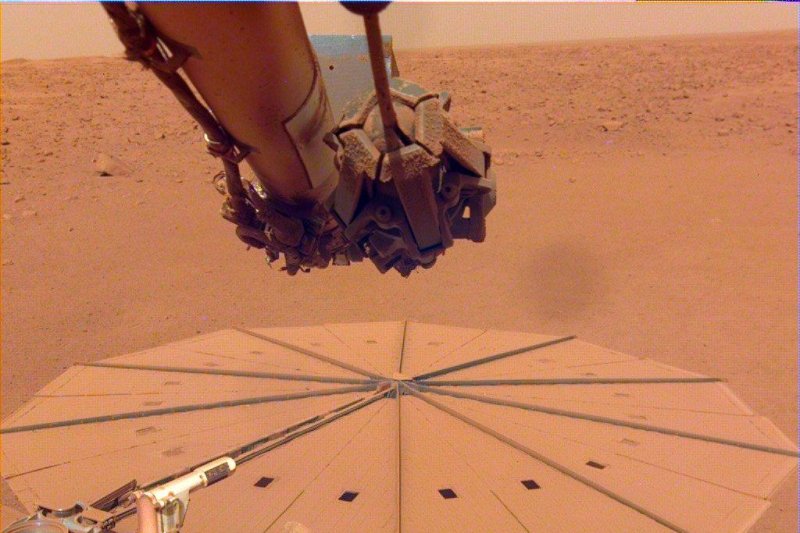1 of 7 | As the Mars InSight lander's power diminishes because of dust on its solar panels, preventing it from charging, NASA engineers plan to power down most of its instruments -- but hold out hope it will be able to wake back up at some point. Photo courtesy NASA/Twitter
ORLANDO, Fla., May 17 (UPI) -- NASA says its InSight Mars lander will run out of power later this summer, ending its science run on the red planet.
Agency officials said at a briefing on Tuesday they are holding out hope that a Martian dust devil could pass over the lander, clearing dust off its solar panels in the process so that it can properly charge up.
Evidence of dust devils has been spotted just tens of miles away from where InSight sits, Bruce Banerdt, principal investigator for the InSight mission and a principal scientist at NASA's Jet Propulsion Laboratory, said during the briefing.
He noted, however, it's unlikely to happen -- but not out of the question completely.
In the meantime, officials said they will power down all of InSight's instruments starting in July, except for its seismometer, though they also will not completely disconnect communications from the lander.
This, they said, will keep sparse communications open just in case InSight is able to wake itself back up.
"InSight has transformed our understanding of the interiors of rocky planets and set the stage for future mission," Lori Glaze, NASA associate administrator of planetary science, said during the briefing.
"We can apply what we've learned about Mars' inner structure to Earth, the Moon, Venus and other rocky planets in other solar systems," Glaze said.
After landing on Mars in 2018, InSight was tasked with probing the planet's interior to learn more about how it works.
The lander has detected more than 1,300 Marsquakes, and scientists think underlying magma reserves on the planet cause the quakes, even though volcanoes aren't actively erupting on the planet's surface.
Despite being ravaged by dust storms and struggling to stay powered, NASA's InSight Mars lander has managed to keep making scientific findings -- including its recent detection of a powerful Marsquake.
The quake, measured by the lander on May 4, was the most intense detected so far by InSight and shook the red planet for more than 9 hours. Those vibrations opened a window into the planet's interior, providing scientists with unprecedented data on Mars' innards.
Banerdt says that the data collected from this massive quake will help scientists further refine their theories on the size and composition of the planet's core, as well as provide new details on the planet's magnetic field.
"Before InSight, we had a fuzzy picture of what the inside of Mars looked like," he said. "Now, we can draw a more precise picture of Mars -- we know the thickness of crust and core, which will shed more light on planetary formation."
While Earthquakes are caused by plate tectonics -- when the plates that make up Earth's crust shift and collide -- Mars doesn't have a crust made up of plates, so planet's tremblers are caused by slightly different phenomena.
"On Mars, quakes are caused by the contraction of the crust due to cooling and vertical motions from thermal uplift or sinking," Banerdt told UPI in an interview on Monday.
"While on Earth most of the seismic activity comes from tectonic plates moving against each other," he said.
Banerdt said that quakes are also caused by forces in the crust or convection in mantle, which also helps to drive plate tectonics.
Imagine baking a cake or muffins, the top of the planet's crust expands and contracts as the middle heats up -- or cooks, in the case of food -- and it expands upwards, pushing against the top. This upward expansion causes cracks in the top of a cake, and has a similar effect on the planetary crust of Mars.
"The most recent quake is bigger than anything we've ever seen," Banerdt said. "It's revealed new details on the Martian interior."
Previous Marsquakes were deeper below the planet's crust, and only detected with InSight's suite of instruments, but the May 4 quake could have been felt if a person were standing on the surface, scientists said.
Registering as a magnitude 5, Banerdt said that while it's weak in comparison to many quakes felt on Earth, it reached an intensity for which scientists have been looking.
The finding is a win for the ailing lander, which in January sat through a massive dust storm that covered its solar panels, making it more difficult for to charge up its batteries.
"Seismic measurements [like these] are crucial to understanding the inner working of rocky bodies like Earth and Mars," Glaze said. "We'd really love to have one at every planet."
Another similar massive dust storm ended the Opportunity rover's extended mission in 2018, after the rover could no longer power itself up.
Glaze said the agency's upcoming Dragonfly mission -- which involves sending a rotorcraft to fly on Saturn's largest moon Titan -- is the next to carry a seismometer. That mission is expected to launch in 2025 and land on Titan in 2034.
NASA's Perseverance Mars rover, using its Mastcam-Z camera system, captured this view of the Martian sunset on November 9, 2021, the 257th Martian day, or sol, of the mission. Martian sunsets typically stand out for their distinctive blue color as fine dust in the atmosphere permits blue light to penetrate the atmosphere more efficiently than colors with longer wavelengths. But this sunset looks different: Less dust in the atmosphere resulted in a more muted color than average. The color has been calibrated and white-balanced to remove camera artifacts. Photo courtesy of NASA |
License Photo
















